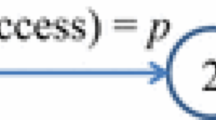Abstract
Systematic packet collisions constitute a major problem in wireless flooding, which is a key mechanism for information dissemination in wireless mesh and multi-hop ad hoc networks. Since this cannot be solved only through classic MAC collision avoidance mechanisms, the IETF has proposed and standardized in RFC 5148 jittering techniques to handle it. These techniques are widely used in protocols for wireless communication such as OLSR, AODV or LOAD, and have proven useful for reducing collisions. They lead however some undesirableside effects that may harm substantially the flooding performance. To the best of our knowledge, no research effort has been deployed to understand and analyze these effects. This paper addresses this issue. It motivates and introduces a theoretical model of flooding with jitter in a wireless interface, as specified in RFC 5148, and explores the probabilistic characterization of additional flooding delay caused by jitter. It mostly provides two analytical bounds for the per-interface additional jitter delay. Presented results, which are validated by way of a discrete-event simulation, enable a better understanding of the performance trade-offs (between packet collisions and additional delay, in particular) underlying the use of jitter in wireless flooding.

















Similar content being viewed by others
Notes
Observe that the case \(i=0\) corresponds to the reception of packet \(p\), which is deterministically received in \(t=0\), so it is excluded from the random process.
Independent and identically distributed.
References
Baccelli, E., Clausen, T., Herberg, U., & Perkins, C. (2009). IP links in multihop wireless networks? In Proceedings of the 17th IEEE international conference on software telecommunications and computer networks (SoftCOM), Split (Croatia), September 2009.
Baccelli, E., Jacquet, P., Nguyen, D., & Clausen, T. (2009). RFC 5449, OSPF multipoint relay (MPR) extension for ad hoc networks, IETF, February 2009.
Broch, J., Maltz, D. A., Johnson, D. B., Hu, Y.-C., & Jetcheva, J. (1998). A performance comparison of multi-hop wireless ad hoc network routing protocols. In Proceedings of ACM international conference on mobile computing and networking (MobiCom’98), pp. 85–97, Dallas, TX (U.S.), October 1998.
Clausen, T., & Jacquet, P. (2003). RFC 3626, optimized link state routing protocol (OLSR), IETF, October 2003.
Clausen, T., Dearlove, C., & Adamson, B. (2008). RFC 5148, jitter considerations in mobile ad hoc networks (MANETs), IETF, February 2008.
Clausen, T., Dearlove, C., Dean, J., & Adjih, C. (2009). RFC 5444, generalized mobile ad hoc network (MANET) packet/message format, IETF, February 2009.
Coltun, R., Ferguson, D., & Moy, J. (2008). RFC 5340, OSPF for IPv6, IETF, July 2008.
Cordero, J. A., Jacquet, P., & Baccelli, E. (2012). Impact of jitter-based techniques on flooding over wireless ad hoc networks: Model and analysis. In Proceedings of the 31st annual IEEE international conference on computer communications (INFOCOM 2012), Florida (United States), March 2012.
Friedman, R., Hay, D., & Kliot, G. (2009). Jittering broadcast transmissions in MANETs: Quantification and implementation strategies.
Fulton, C. A., & Li, S. (1998). Delay jitter first-order and second-order statistical functions of general traffic on high-speed multimedia networks. In IEEE/ACM Transactions on Networking, 6(2), Apr. 1998.
ISO (2002). ISO/IEC 10589:2002(E), Information technology—telecommunications and information exchange between systems—intermediate system to intermediate system intra-domain routeing information exchange protocol for use in conjunction with the protocol for providing the connectionless-mode network service (ISO 8473). International Organization for Standardization, 2002.
Moy, J. (1998). RFC 2328, OSPF version 2, IETF, April 1998.
Ni, S.Y., Tseng, Y.-Ch., Chen, Y.-S., & Sheu, J.-P. (1999). The broadcast storm problem in a mobile ad hoc network. In Proceedings of the annual international conference on mobile computing and networking, pp. 151–161, ACM Press, Seattle (United States), August 1999.
Oliveira, R., Bernardo, L., & Pinto, P. (2009). The influence of broadcast traffic on IEEE 802.11 DCF networks. In Computer communications, 32(2), 439–452, February 2009.
Perkins, C., Belding-Royer, E., & Das, S. (2003). RFC 3561, Ad hoc on-demand distance vector (AODV) Routing, IETF, July 2003.
Roy, A., & Chandra, M. (2010). RFC 5820, extensions to OSPF to support mobile ad hoc networking, IETF, March 2010.
Takagi, H., & Kleinrock, L. (1984). Optimal transmission ranges for randomly distributed packet radio terminals. In IEEE Transactions on Communications, vol. COM-32, no. 3, March 1984.
Zheng, L., Zhang, L., & Xu, D. (2001). Characteristics of network delay and delay jitter and its effect on voice over IP (VoIP). In Proceedings of the IEEE international conference of communications (ICC 2001), vol. 1, pp. 122–126, Helsinki (Finland), June 2001.
Author information
Authors and Affiliations
Corresponding author
Rights and permissions
About this article
Cite this article
Cordero, J.A. A Probabilistic Study of the Delay Caused by Jittering in Wireless Flooding. Wireless Pers Commun 73, 415–439 (2013). https://doi.org/10.1007/s11277-013-1195-8
Published:
Issue Date:
DOI: https://doi.org/10.1007/s11277-013-1195-8




